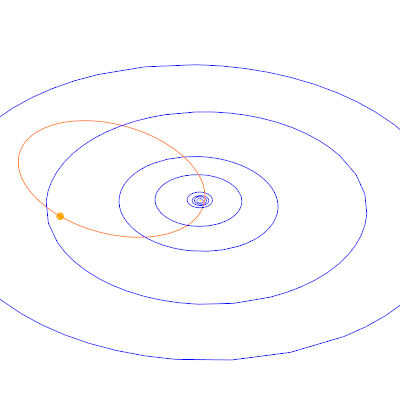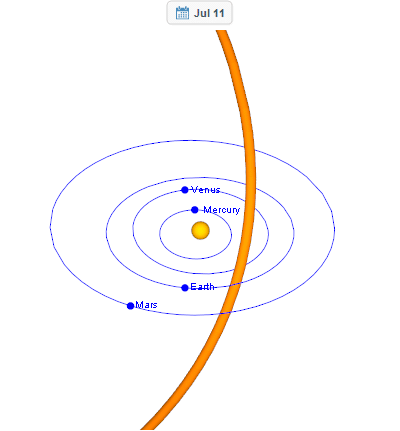Meteor showers are an annual occurrence. Each meteor shower happens at about the same time every year. One of the better meteor showers to catch, at least in the northern hemisphere, is the Perseid meteor shower.
In[1]:= Entity["MeteorShower", "Perseids"]["PeakDate"]
Out[1]= DateObject[{2016, 8, 12}]
Meteor showers are usually the result of Earth moving through the dusty debris trail of a periodic comet. As comets orbit the Sun, they leave behind a dusty cloud in their wake. Some comet orbits pass near the orbit of Earth and so the Earth intercepts some of this dirt and gravel. In the case of the Perseid meteor shower, the parent object is Comet Swift-Tuttle.
In[2]:= Entity["MeteorShower", "Perseids"]["ParentObject"]
Out[2]= Entity["Comet", "Comet109PSwiftTuttle"]
The orbit of this comet can be visualized using the following WL code.
With[{date = DateObject[{2016, 8, 11}]},
Graphics3D[{RGBColor[1, .7,
0], {Lighting -> {{"Ambient", GrayLevel[.3]}, {"Directional",
White, ImageScaled[{0, 0, 1}]}}, Sphere[{0, 0, 0}, .1]},
PointSize[.02], {{Orange,
Lighting -> {{"Ambient", GrayLevel[.3]}, {"Directional", White,
ImageScaled[{0, 0, 1}]}}, #[[1]]},
Point[QuantityMagnitude[#[[2]]]]} &@
EntityValue[
Entity["Comet", "Comet109PSwiftTuttle"], {"OrbitPath",
EntityProperty["Comet", "HelioCoordinates", {"Date" -> date}]}],
Blue, EntityValue[EntityClass["Planet", All], "OrbitPath"]},
PlotRange -> 45, ViewAngle -> Pi/20, Boxed -> False,
ImageSize -> 400]]

If we zoom into the inner solar system, we can represent the comet's orbit as a tube and watch as Earth passes through the comet's orbit path as we approach August 11.
frames = Table[
With[{date = DateObject[{2016, 7, 11 + t}]},
Column[{DateObject[date[[1]],
DateFormat -> {"MonthNameShort", " ", "DayShort"}],
Graphics3D[{RGBColor[1, .7,
0], {Lighting -> {{"Ambient", GrayLevel[.3]}, {"Directional",
White, ImageScaled[{0, 0, 1}]}}, Sphere[{0, 0, 0}, .1]},
PointSize[.02], {{Orange,
Lighting -> {{"Ambient", GrayLevel[.3]}, {"Directional",
White, ImageScaled[{0, 0, 1}]}}, #[[1]] /.
Line -> Tube}, Point[QuantityMagnitude[#[[2]]]]} &@
EntityValue[
Entity["Comet", "Comet109PSwiftTuttle"], {"OrbitPath",
EntityProperty["Comet",
"HelioCoordinates", {"Date" -> date}]}],
Blue, {#[[1]], {Text[#[[1]],
QuantityMagnitude[#[[2]]], {-1.5, 0}] & /@
Transpose[{#[[3]], #[[2]]}],
Point[QuantityMagnitude[#[[2]]]]}} &@
Transpose[
EntityValue[{Entity["Planet", "Earth"],
Entity["Planet", "Venus"], Entity["Planet", "Mercury"],
Entity["Planet", "Mars"]}, {"OrbitPath",
EntityProperty["Planet",
"HelioCoordinates", {"Date" -> date}], "Name"}]]},
PlotRange -> 4, ViewAngle -> Pi/20, Boxed -> False,
ImageSize -> 400]}, Center]],
{t, 0, 60, .5}];

Depending on the weather in your location, you should try going out over the next couple of days, especially tonight, and look for any "shooting stars" that are a result of the dusty debris of a comet burning up in our atmosphere. The best time is anytime after midnight and before dawn. Meteors can appear anywhere in the sky and will appear to radiate from a point in the northeast, in the constellation Perseus, where the meteor shower gets its name. You don't need binoculars or a telescope, just a blanket and your eyes.